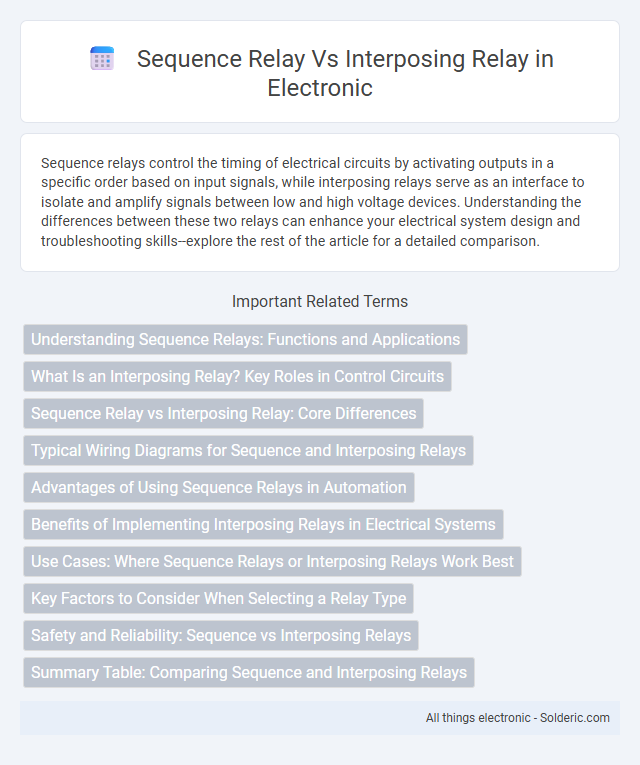Sequence relays control the timing of electrical circuits by activating outputs in a specific order based on input signals, while interposing relays serve as an interface to isolate and amplify signals between low and high voltage devices. Understanding the differences between these two relays can enhance your electrical system design and troubleshooting skills--explore the rest of the article for a detailed comparison.
Comparison Table
| Feature | Sequence Relay | Interposing Relay |
|---|---|---|
| Purpose | To provide time-sequenced control in protection systems | To interface control signals between devices with different voltage/current levels |
| Application | Used in protective relaying for sequential operation | Used to isolate and amplify control signals |
| Operation | Operates based on a predetermined sequence for tripping and resetting | Operates as an interface relay responding to input control signals |
| Functionality | Manages time delay and sequencing of relay actions | Acts as a buffer and isolator between different circuit parts |
| Time Delay | Usually includes built-in time delay mechanisms | No inherent time delay, immediate response |
| Relay Contacts | Multiple contacts operating in sequence | Single or multiple contacts used for signal interfacing |
| Typical Use Case | Power system protection and automation requiring timed sequences | Control signal adaptation and isolation in control circuits |
Understanding Sequence Relays: Functions and Applications
Sequence relays are designed to control the operation of devices in a specific order, ensuring processes occur step-by-step based on timing or input conditions. They find applications in industrial automation, where precise control over sequential operations is necessary to prevent equipment damage or ensure safety. Understanding how sequence relays manage timing and interlocks helps optimize your control systems for efficient and reliable performance.
What Is an Interposing Relay? Key Roles in Control Circuits
An interposing relay acts as an intermediary device that isolates control circuits from high-voltage or high-current components, ensuring safe operation and preventing direct electrical connection between control devices and power loads. It plays a crucial role in control circuits by enabling low voltage control signals to operate higher voltage equipment, providing necessary signal amplification and circuit protection. This relay type enhances system reliability by facilitating the integration of different control devices through standardized electrical interfaces.
Sequence Relay vs Interposing Relay: Core Differences
Sequence relays control a series of events by monitoring multiple inputs to ensure proper operational timing, primarily used in protection schemes for sequential logic applications. Interposing relays act as intermediaries, isolating and amplifying control signals between devices, facilitating safe interface between different voltage levels or control circuits. The core difference lies in the sequence relay's focus on event completion order and timing, whereas the interposing relay emphasizes signal isolation and voltage adaptation.
Typical Wiring Diagrams for Sequence and Interposing Relays
Typical wiring diagrams for sequence relays feature multiple input contacts arranged to actuate outputs in a predefined order, ensuring step-by-step operation in control circuits. Interposing relay diagrams commonly show a single input coil controlling multiple contacts to interface between low-voltage control signals and high-voltage circuits, effectively isolating and expanding contact capacity. Sequence relay wiring emphasizes sequential logic interlocks, while interposing relay schematics prioritize signal amplification and isolation.
Advantages of Using Sequence Relays in Automation
Sequence relays offer precise control by ensuring operations occur in a specific, predefined order, reducing the risk of equipment damage caused by incorrect sequences. Their ability to simplify complex automation processes lowers wiring complexity and enhances troubleshooting efficiency. You benefit from improved system reliability and consistent performance in automated environments by using sequence relays.
Benefits of Implementing Interposing Relays in Electrical Systems
Interposing relays enhance electrical system reliability by isolating control circuits from high-power loads, reducing contact wear and minimizing the risk of coil burnout. They facilitate compatibility between control devices operating at different voltage levels, ensuring seamless integration and extending the lifespan of primary relays. Improved signal amplification and noise immunity offered by interposing relays contribute to more stable operation in complex automation environments.
Use Cases: Where Sequence Relays or Interposing Relays Work Best
Sequence relays are ideal for controlling multi-step processes in automation systems, ensuring operations occur in a defined order, such as conveyor belt sequencing or motor startup procedures. Interposing relays excel in isolating control circuits from high-power devices, protecting sensitive components in applications like industrial motor controls or lighting circuits. Your choice depends on whether you need precise operation sequencing or enhanced electrical isolation and protection.
Key Factors to Consider When Selecting a Relay Type
When selecting a relay type, key factors include the application's complexity, load requirements, and response time. Sequence relays are ideal for controlling multiple operations in a predetermined order, offering precise timing and logic control, while interposing relays serve as intermediaries to isolate circuits and adapt signal levels. Your choice depends on whether you need coordinated sequencing or simple signal interfacing to ensure reliable and efficient electrical control.
Safety and Reliability: Sequence vs Interposing Relays
Sequence relays offer enhanced safety by ensuring operations occur in a precise, predefined order, preventing equipment damage and hazardous conditions. Interposing relays improve reliability by isolating control circuits from high-power devices, reducing the risk of electrical faults affecting system performance. Your safety and system integrity depend on selecting the appropriate relay type based on the specific control and protection requirements.
Summary Table: Comparing Sequence and Interposing Relays
Sequence relays control multiple operations in a predetermined order using time delays, ideal for sequential control in automation systems, while interposing relays serve as intermediaries to isolate control circuits from high-voltage loads, enhancing safety and reducing wear on control switches. Sequence relays typically feature timer contacts and are designed for delaying or sequencing actions, whereas interposing relays have simple switching elements used to amplify current or voltage signals. Key parameters for comparison include function (sequencing vs isolation), application (automation control vs circuit isolation), coil voltage ratings, contact configurations, and response time, with sequence relays focusing on timed operations and interposing relays on signal interfacing.
Sequence relay vs interposing relay Infographic

 solderic.com
solderic.com